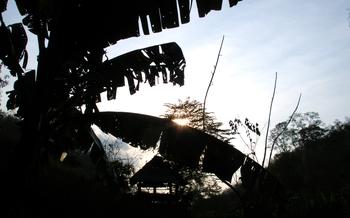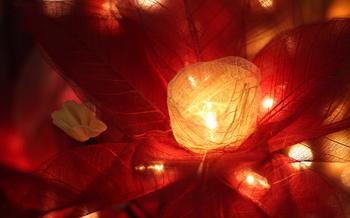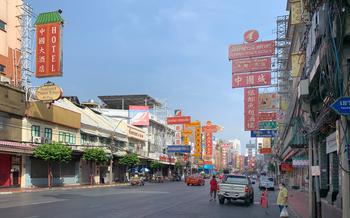
Ban Pa Ao Silk Village
- Ban Pa Ao Silk Village: A Living Museum of Thai Silk Heritage
- Exploring the Village: A Journey into the World of Silk
- Witnessing the Magic of Silk Production
- Shopping for Authentic Silk Products
- Learning about the Mulberry Life Cycle
- Observing the Silkworms' Lifecycle
- Admiring the Village's Natural Beauty
- Experiencing Local Culture and Traditions
- Sampling Delicious Local Cuisine
- Exploring the Village's Surroundings
- Planning Your Visit: Practical Considerations
- Capturing the Essence of Ban Pa Ao through Photography
- Preserving the Legacy of Thai Silk: Conservation Efforts
- Insider Tip: Unveiling Hidden Gems
Ban Pa Ao Silk Village: A Living Museum of Thai Silk Heritage
Nestled in the heart of Ubon Ratchathani, Thailand, the picturesque village of Ban Pa Ao stands as a living testament to the enduring legacy of Thai silk. With a history deeply entwined with the art of silk-making, the village has become a renowned center for the production of exquisite silk textiles, capturing the essence of Thailand's rich cultural heritage.
The tradition of silk-making in Ban Pa Ao dates back generations, passed down from skilled artisans to their eager apprentices. The villagers have meticulously preserved their ancestral techniques, ensuring that each piece of silk created within the village carries the weight of history and tradition.
A visit to Ban Pa Ao Silk Village offers a unique glimpse into the fascinating world of Thai silk production. From the cultivation of mulberry trees to the intricate weaving of delicate threads, visitors can witness the entire process firsthand, immersing themselves in the vibrant colors and intricate patterns that define this timeless craft.
Exploring the Village: A Journey into the World of Silk
As you wander through the alleys of Ban Pa Ao Silk Village, you'll notice that it's divided into different sections, each dedicated to a specific stage of the silk-making process. In one section, you'll find mulberry fields, where villagers cultivate the leaves that serve as the primary food source for silkworms. In another section, you'll witness the sericulture process, where silkworms are raised, cared for, and harvested for their precious cocoons.
At the heart of the village, you'll find the silk-making workshops, where the magic truly happens. Here, you can observe skilled artisans demonstrating the intricate steps involved in transforming mulberry leaves into exquisite silk threads. Watch as they carefully select cocoons, boil them to extract the silk fibers, and skillfully spin them into delicate threads using traditional spinning wheels.
Don't miss the opportunity to interact with the local artisans and learn firsthand about their silk production techniques. They'll gladly share their knowledge and stories, providing you with a deeper understanding of the art and craft of Thai silk.
Witnessing the Magic of Silk Production
The silk-making process at Ban Pa Ao Silk Village is a captivating spectacle that transports visitors to a realm of artistry and precision. From the initial stage of mulberry leaf cultivation to the final weaving of delicate silk threads, each step is a testament to the skill and dedication of the local artisans.
Visitors can witness the intricate process of transforming mulberry leaves into shimmering silk. The leaves, carefully harvested at their peak, are meticulously sorted and cleaned to remove impurities. Skilled hands then feed the leaves into a machine that gently crushes and separates the delicate fibers from the rest of the plant material.
The extracted fibers, known as silk cocoons, are then spun into fine threads using traditional spinning wheels. This intricate task requires a keen eye and steady hand, as the threads must be of uniform thickness and strength. The resulting silk threads, shimmering in their natural ivory hue, are then ready for dyeing and weaving.
The dyeing process at Ban Pa Ao Silk Village is an art in itself. Artisans use natural dyes derived from plants, minerals, and insects to create a vibrant palette of colors. The threads are carefully immersed in dye baths, and the timing and temperature are precisely controlled to achieve the desired shade.
Once dyed, the threads are meticulously woven into beautiful fabrics using traditional looms. The weavers, with their nimble fingers and years of experience, create intricate patterns and designs that reflect the rich cultural heritage of Thailand. The finished silk products, whether scarves, garments, or home décor items, are a testament to the skill and artistry of the village's artisans.
Shopping for Authentic Silk Products
Visiting Ban Pa Ao Silk Village is an excellent opportunity to purchase authentic and high-quality silk products directly from the artisans who create them. The village offers a wide range of silk items, including scarves, garments, home décor items, and more, all showcasing the exquisite craftsmanship and vibrant colors that are synonymous with Thai silk.
When shopping for silk products in the village, it is essential to identify high-quality silk. Look for products with a smooth, even texture and a lustrous sheen. The silk should feel soft and drape beautifully. Genuine silk will also have a distinct "snap" or "crackling" sound when you crumple it.
Bargaining is acceptable in the village, but it should be done respectfully. Start by offering a fair price and be prepared to negotiate. Remember that the artisans rely on their sales for their livelihood, so it is essential to be fair and respectful in your negotiations.
By purchasing silk products from Ban Pa Ao Silk Village, you not only support local artisans but also contribute to preserving traditional craftsmanship and the cultural heritage of Thailand.
Learning about the Mulberry Life Cycle
Mulberry trees, with their lush foliage and vibrant green leaves, play a crucial role in the silk-making process. In Ban Pa Ao, visitors can witness the entire mulberry life cycle, from the cultivation of the trees to the harvesting of their leaves. The villagers have mastered the art of mulberry cultivation, ensuring a steady supply of fresh, high-quality leaves for their silkworms. Visitors can stroll through the mulberry fields, observing the various stages of growth and development of these remarkable trees. The mulberry leaves provide essential nutrition to the silkworms, influencing the quality and color of the silk they produce. Understanding the mulberry life cycle deepens the appreciation for the intricate process of silk production and the harmonious relationship between nature and craftsmanship in Ban Pa Ao.
Observing the Silkworms' Lifecycle
The Ban Pa Ao Silk Village offers a unique opportunity to witness the captivating metamorphosis of silkworms, from their humble beginnings as tiny eggs to their transformation into beautiful moths. Each stage of their life cycle is a testament to nature's intricate wonders, unfolding before the eyes of visitors.
The journey begins with eggs, carefully laid by female moths on mulberry leaves. These eggs, no larger than a pinhead, are meticulously collected and placed in a controlled environment to ensure optimal conditions for hatching. As the eggs mature, they transform into tiny caterpillars, known as larvae. These larvae, with their insatiable appetites, feast on mulberry leaves, growing larger and molting several times as they progress through their larval stage.
As the larvae reach maturity, they spin cocoons around themselves, using a remarkable silk filament secreted from their bodies. Inside these silken cocoons, the larvae undergo a remarkable transformation, evolving into pupae. During this stage of metamorphosis, the pupae develop wings, antennae, and other features characteristic of adult moths.
Finally, the cocoons burst open, revealing the emergence of beautiful moths. These moths, with their vibrant colors and delicate wings, are a testament to the wonder of nature's artistry. Visitors to the village can witness this magical transformation firsthand, gaining a deeper appreciation for the intricate process that results in the creation of exquisite silk.
Admiring the Village's Natural Beauty
Ban Pa Ao Silk Village is nestled amidst a serene and picturesque landscape that adds to its charm and appeal. Surrounded by lush mulberry fields, tranquil waterways, and verdant greenery, the village offers a tranquil escape from the hustle and bustle of city life. Visitors can stroll through the village, taking in the beauty of the natural surroundings and capturing stunning photos of the idyllic scenery.
The mulberry fields, with their rows of neatly planted mulberry trees, create a vibrant tapestry of green that stretches as far as the eye can see. The trees provide not only the leaves that feed the silkworms but also a habitat for various insects and birds, contributing to the biodiversity of the area. The tranquil waterways, lined with lush vegetation, meander through the village, adding a touch of serenity to the atmosphere.
Visitors can take a leisurely walk along the banks of the waterways, enjoying the cool breeze and the sounds of nature. The village's surroundings are ideal for nature lovers and photographers, who can capture the essence of rural Thailand in their images. Whether it's the golden hues of a sunset over the mulberry fields or the vibrant colors of the village's flora and fauna, Ban Pa Ao offers endless opportunities for capturing stunning photographs.
Experiencing Local Culture and Traditions
Visiting Ban Pa Ao Silk Village is not just about learning about silk production; it is also an opportunity to immerse yourself in the local culture and traditions. The villagers are renowned for their warm hospitality and friendly smiles, and they are always eager to share their way of life with visitors. You can interact with the villagers, learn about their daily routines, and gain insights into the cultural significance of silk in Thai society. Whether it's observing traditional ceremonies, participating in hands-on workshops, or simply sharing a meal with the locals, you will come away with a deeper understanding and appreciation for the rich cultural heritage of Ubon Ratchathani.
Sampling Delicious Local Cuisine
A visit to Ban Pa Ao Silk Village is not complete without experiencing the tantalizing flavors of local Ubon Ratchathani cuisine. The village offers a range of culinary delights, from simple street food stalls to cozy restaurants, each showcasing the unique flavors of the region. Indulge in mouthwatering dishes prepared with fresh, locally grown ingredients, reflecting the culinary traditions of Ubon Ratchathani.
Don't miss the chance to savor the famous "khao poon," a regional specialty consisting of rice noodles in a rich and flavorful broth, often accompanied by tender pieces of meat or vegetables. Another must-try is the spicy "som tum," a green papaya salad that packs a punch with its combination of tart, sweet, and savory flavors.
For those with a sweet tooth, the village offers a variety of delectable desserts, including the popular "khanom chan," a steamed coconut cake with a soft and chewy texture. Be sure to sample the local fruits, such as sweet mangoes and juicy pineapples, which are often used in local desserts and beverages.
When exploring the village, keep an eye out for the many food stalls and vendors selling snacks and refreshments. Try the crispy "khanom krok," coconut pancakes cooked in a special mold, or the savory "sai krok Isan," a type of fermented sausage unique to the region.
Remember to embrace the local culture and customs when dining in the village. Show respect by greeting the vendors and asking permission before taking photos. Your friendly and open attitude will be warmly welcomed by the locals, who are always happy to share their culinary treasures with visitors.
Exploring the Village's Surroundings
Beyond the immediate confines of the silk village, visitors can embark on a journey of discovery into the surrounding countryside. A short walk or bicycle ride leads to tranquil temples adorned with intricate carvings and colorful murals, offering a glimpse into the spiritual heart of the region. For a taste of local life, the bustling markets offer a vibrant array of fresh produce, handmade crafts, and delectable street food. Nature enthusiasts can explore the nearby natural landmarks, such as cascading waterfalls, serene lakes, and lush forests, providing a welcome respite from the village's bustling activity. With so much to see and do in the vicinity, visitors can create a memorable itinerary that seamlessly blends culture, nature, and adventure, ensuring a truly immersive experience in Ubon Ratchathani.
Planning Your Visit: Practical Considerations
Visiting Ban Pa Ao Silk Village is a rewarding experience that offers a glimpse into the fascinating world of Thai silk production. To make the most of your trip, it's important to consider a few practical aspects.
Best Time to Visit: The village is open to visitors year-round, but the best time to visit is during the dry season (November to April) when the weather is pleasant and the silk production activities are at their peak. During this time, you'll witness the entire silk-making process, from mulberry cultivation to weaving, and have the chance to see the vibrant colors and intricate patterns created by the local artisans.
Dress Code and Cultural Etiquette: When visiting the village, it's important to dress respectfully and observe local customs. Avoid wearing revealing or overly casual clothing, and be mindful of your behavior when interacting with the villagers. Remember that the village is a working community, so please be respectful of the artisans' time and space.
Transportation Options: The village is located about 60 kilometers from Ubon Ratchathani city. The most convenient way to get there is by taking a local bus from the city's bus station. The journey takes approximately 1 hour and 30 minutes. Alternatively, you can hire a private car or taxi for a more comfortable and direct journey.
Capturing the Essence of Ban Pa Ao through Photography
As you wander through Ban Pa Ao Silk Village, you'll be captivated by the vibrant colors, intricate patterns, and skillful hands of the local artisans. Capturing the beauty of this living museum through photography is an incredible way to preserve your memories and share the village's story with the world.
Tips for Ethical and Respectful Photography: - Seek Permission: Before photographing the villagers, always ask for their permission. Respect their privacy and wishes, and avoid taking photos that make them uncomfortable. - Capture the Process: Focus on capturing the various stages of silk production, from mulberry cultivation to weaving. Showcase the artisans' skills and techniques, and the transformation of raw materials into beautiful silk products. - Compose Your Shots: Experiment with different angles and perspectives to create visually appealing compositions. Utilize natural light to enhance the colors and textures of the silk. - Respect the Environment: Be mindful of your impact on the village's environment. Avoid disturbing the mulberry fields or waterways, and dispose of your waste responsibly.
Preserving the Legacy of Thai Silk: Conservation Efforts
The Ban Pa Ao Silk Village is not merely a tourist attraction; it serves as a living museum dedicated to preserving the time-honored traditions of Thai silk making. Recognizing the cultural significance of this craft, various initiatives have been undertaken to protect and promote the village's unique heritage.
One of the key initiatives is the promotion of sustainable tourism. By encouraging visitors to explore the village and purchase authentic silk products, tourism plays a crucial role in supporting the local artisans and ensuring the continuation of their craft. Visitors are encouraged to engage with the villagers, learn about their techniques, and appreciate the intricate details of their work.
Another vital conservation effort involves the documentation and preservation of traditional silk-making practices. Researchers and cultural experts work closely with the villagers to document the various stages of silk production, from mulberry cultivation to weaving. This documentation helps preserve the knowledge and skills associated with Thai silk making for future generations.
Education programs are also implemented to raise awareness about the importance of Thai silk and the need for its preservation. Workshops, demonstrations, and exhibitions are organized to educate visitors and students about the history, techniques, and cultural significance of silk production. By fostering a deeper understanding and appreciation for Thai silk, these programs help ensure its legacy continues to thrive.
By supporting conservation efforts and promoting sustainable tourism, visitors can play a vital role in preserving the rich heritage of Thai silk and ensuring that the Ban Pa Ao Silk Village remains a vibrant center of this ancient craft for generations to come.
Insider Tip: Unveiling Hidden Gems
Beyond the main tourist areas of Ban Pa Ao Silk Village, there are hidden gems waiting to be discovered. Venture off the beaten path to explore the lesser-known corners of the village and uncover unique experiences. Engage with the friendly locals, who are always happy to share their stories and insights into their craft. Ask them about their favorite spots in the village, and they might lead you to hidden workshops where artisans create exquisite silk products using traditional techniques passed down through generations. These artisans often have one-of-a-kind pieces that you won't find in the main shopping area, making them truly special souvenirs.
Embrace the opportunity to learn about the personal stories and experiences of the villagers. They are the heart and soul of Ban Pa Ao, and their passion for silk making is contagious. Listen to their tales of how they got started in the craft, the challenges they've faced, and the joys of creating beautiful silk products. These interactions will give you a deeper appreciation for the village and its rich cultural heritage.
So, take the time to explore beyond the main tourist spots and uncover the hidden gems of Ban Pa Ao Silk Village. You'll be rewarded with unique experiences, one-of-a-kind souvenirs, and a deeper understanding of the village's vibrant silk-making traditions.




